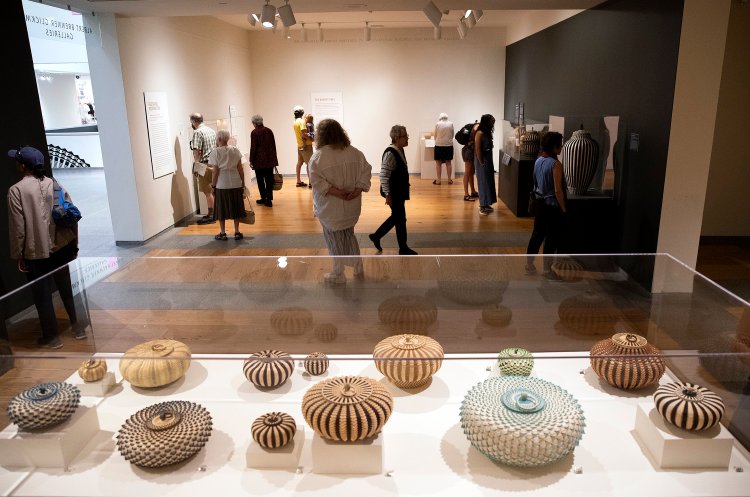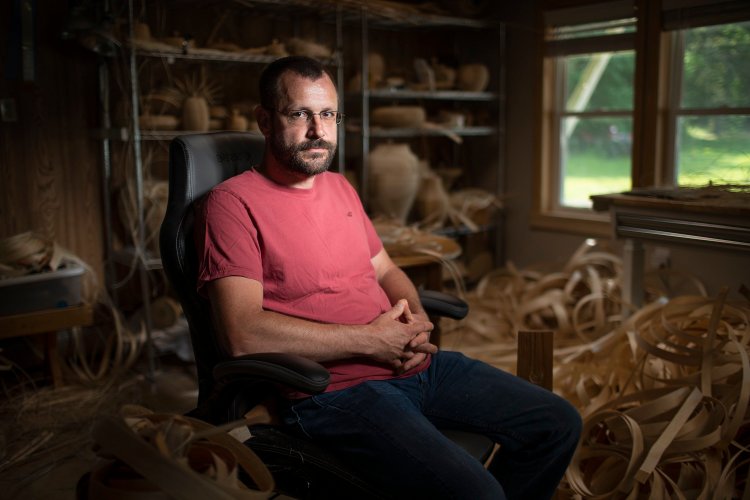Jaime De Simone knew Passamaquoddy basketmaker Jeremy Frey had blue ribbons in his studio and collectors all over the world. But in 2021, when she was working as a curator at the Portland Museum of Art, she accompanied him to the prestigious Santa Fe Indian Market in New Mexico.
What she witnessed there, she said, was “celebrity status.”
“I quickly was observing how he was positioning himself and how well established he was on a national scale,” said De Simone, who is now the chief curator at the Farnsworth Museum of Art in Rockland. “People were flocking to his booth. People lined up before it even opened. By 9 a.m., people were there wanting to purchase all of them. I was in awe.”
Frey has been making baskets for more than two decades. Recently, he shot onto the contemporary art scene. Last year, Karma Gallery in New York started representing his work. This summer, the Portland Museum of Art is presenting “Woven,” an exhibition that will travel to venues such as the Art Institute of Chicago.
It is not only his first solo show in a fine art museum – it is the first for any Wabanaki artist. But it was in 2011 that Frey won Best in Show in Santa Fe and at the Heard Museum Guild Indian Fair and Market in Phoenix in the same year, a nearly unheard-of feat. And basketry is the oldest art form practiced in Maine. The precise weaves and mesmerizing shapes in the gallery today raise the question: Why did this recognition take so long?
“There’s been a lack of respect for a long time,” said Theresa Secord, the founding director of the Maine Indian Basketmakers Alliance and a longtime friend of Frey. “It’s funny because I’ve served on boards for 40 years and sometimes been the only Native American in the room. It’s just amazing now there’s so much interest in Native American art, and I’ve been getting commissions at museums that wouldn’t look at one of my baskets 10 years ago. I can’t really explain it, but I will say, as far as our basketry, Jeremy himself has a lot to do with that.”
One basket, titled “Navigating Tradition” (2023), was first displayed in a solo exhibition for Frey at Karma. The outside is undyed ash in a simple woodland style. The inside is dyed in vibrant hues of red and purple, another basket entirely.
“One of the things I’ve been trying to do as far as the way I put myself in the world is less about traditional basketmaking and more as a contemporary artist, right?” Frey said. “Because I did that for years, you know. But neither one of them is mutually exclusive.”
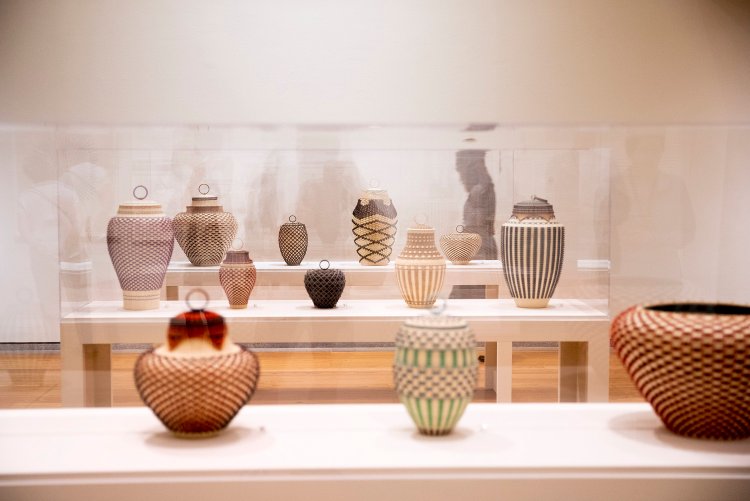

Jeremy Frey’s exhibit “Woven” at the Portland Museum of Art. Frey is a seventh-generation Passamaquoddy basket maker, who learned weaving techniques from his mother and apprenticeships through the Maine Indian Basketmakers Alliance. Derek Davis/Staff Photographer
PAVING HIS WAY
Frey, 45, grew up in Indian Township in a household where money was tight.
“Our toys were like a pencil and paper, art supplies, a little jackknife to carve things with,” he said. “Those were my games, really. If I was to play a game, I’d draw it.”
He worked in restaurants when he got older, and he struggled with drugs and alcohol. When he came home to get away from the partying, his mother was relearning basketry from an elder in the community. Their family had deep ties to the tradition – Jeremy is the seventh generation to practice weaving – but he had never tried it. Gal Frey suggested that he start, and he found something he needed.
“Coming out of drug addiction and a hard life, I needed some meditation,” he said.
Traditionally, makers harvest their own materials. The ash tree is sacred – and endangered by the emerald ash borer. Hunting for a healthy tree is a deeply rooted tradition, and the location of such a grove is a tightly held secret. Years ago, the first time Frey cut a tree himself, he chose the wrong kind. His uncle finally decided to teach him the trade.
“That’s what finally motivated him to take me into the woods,” Frey said with a chuckle, ” ‘No nephew of mine … ’ ”
Founded in 1993, the Maine Indian Basketmakers Alliance set out to preserve the art of ash and sweetgrass basketry. Secord first met Frey in 2002 at a workshop on the reservation at Pleasant Point. His mother asked if her son could pound and split ash wood in exchange for $50 for gas money to get to the workshop. Secord says now that she wrote his first artist paycheck that day.
The alliance would be critical to Frey as he built his career; Secord was the one who nominated him for the United States Artists Fellowship he received in 2010, when he was the youngest artist to ever win the award at 32. But most impressive to her is the way Frey got to this point without the traditional networks that some build in formal art school.
“If you got an MFA, you have professors who are already pushing you to have shows in museums,” Secord said. “You probably had a senior show for your BFA and all these connections. Those were available to other artists and not to Jeremy. He had to pave his way.”
STANDING OUT
At markets, Frey would visit every table and study every basket. He set a goal: “I would try to make something no one had seen before.”
“I thought to myself, ‘If I’m going to try and do this for a living, I have to stand out,’ because this was the place where you sell them,” Frey said.
In 2009, Frey went to the Santa Fe Indian Market for the first time with the Maine Indian Basketmakers Alliance. It is the largest Indigenous arts market in North America and also includes jewelry, pottery, textiles, paintings, and sculptures. He couldn’t enter his work in the juried competition because he came to the market with a nonprofit, and the following year, he skipped it out of frustration. In 2011, he returned – and won the top prize, the first time a basket had done so in the market’s long history. Today, ribbons of many colors are tacked onto a ceiling beam in Frey’s studio near Bangor.
Andrew Hamilton is the associate curator of art of the Americas at the Art Institute of Chicago, the next destination for “Woven” in October. He first encountered Frey’s work in the Southwest and has judged his baskets in competitions. Even his largest works, he said, have an extraordinary level of detail.
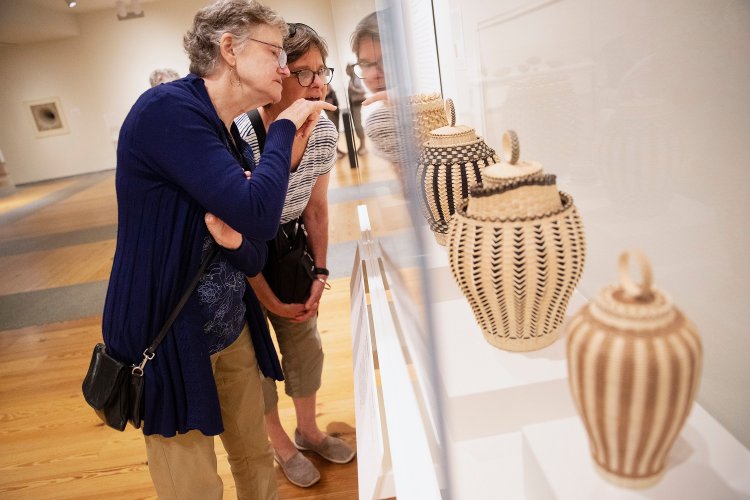

Iris Silverstein, of Topsham, left, and Penny Hood, of Farmington, look at Jeremy Frey’s exhibit “Woven” at the Portland Museum of Art. Derek Davis/Staff Photographer
“His pieces just, in fact, sort of puzzled me the first time I saw one of his baskets because it was so intricate and had so many layers and so many woven structures,” Hamilton said. “I was like, ‘How does he do that?’ I’m someone who does a lot of research, and I think I’m pretty good at puzzling out how something woven is made. His work is so intricate and astounded me.”
The exhibition includes baskets spanning Frey’s career. Early pieces from his mother’s own collection show a fine weave, a technique that Secord said dates back 100 years but was no longer common when Frey started using it. Today, the precise technique features even in Frey’s larger baskets and is a common thread in the show. Another hallmark of Frey’s work is braided ash wood and cedar bark. Secord said she knows of no one else who had done this painstaking detail before now. A number of baskets include designs made of porcupine quills, a skill he also first learned from his mother.
“He’s making unprecedented design innovations within the art form that previous generations of Wabanaki basket makers had not,” said Ramey Mize, assistant curator of American art at the Portland Museum of Art. “So there’s a lot of novelty and experimentation, but he always comes back to the foundational principles of Wabanaki basketry.”
MUSEUM RECOGNITION
The going rate for a good basket used to be $30. For decades, weavers just tried to sell enough in a month to cover the electric bill. The boldest elders set prices at $100 or even $125.
When Frey started to develop a following, Secord said his prices caused some tension in the community. Younger basket makers traditionally set prices lower than their teachers as a sign of respect. But Secord said he has since helped increase the market so baskets are now getting fairer prices. Frey would not say what he sells his baskets for now, but Secord said others are able to charge four or even five figures at markets and for commissions.
His mentor said even she raised her eyebrows a bit at his ambition over the years.
“I thought to myself, ‘Good luck with that. This kid is good, but what is he thinking, really?’ And by god, he’s done it,” Secord said.
Mize said Frey saw his career take off out West in part because buyers and institutions in Maine had long overlooked this art form.
“Basketry and Indigenous art has been subject to stereotype and bias by the quote-unquote fine art world that seeks to instate really arbitrary divisions between quote-unquote craft and quote-unquote art,” Mize said. “Baskets were sold as a means of survival by Wabanaki people in order to safeguard this deeply important cultural tradition but also as income to survive post colonization. So a lot of Mainers saw these works in the context of these markets that would spring up on tourist routes in Bar Harbor and other coastal resort areas. They saw them in the sphere of souvenirs or curios, as a keepsake of your travels. I think that’s why Jeremy wasn’t as legible to Mainers for a long time.”
For years, Wabanaki art was exhibited mostly in ethnographic museums, such as the Abbe Museum in Bar Harbor. In 2015, Frey and Secord were among the basket makers invited to display their work at the Portland Museum of Art biennial for the first time. In 2019, Colby College Museum of Art hosted an exhibition titled “Wíwɘnikan … the beauty we carry,” which for the first time included Wabanaki curators and consultants. Secord, who now sits on the boards for both, said she sees museums today making a greater effort to show and acquire work by underrepresented artists, including those from Indigenous communities.
The 50 or so baskets in “Woven” came not only from private collectors but also from major museums. Some, such as the National Museum of the American Indian in Washington, D.C., focus exclusively on Indigenous people and objects. Others have a fine art focus, such as the Farnsworth Art Museum in Rockland and the Smithsonian American Art Museum.
“A museum acquisition signifies validation in your practice,” De Simone said. “We wanted to make it front and center that he’s in the Smithsonian, Bowdoin, Colby, the Denver Art Museum.”
NEW GOALS
“Woven” grew out of a conversation De Simone had with Frey in 2021 during that trip to Santa Fe. She had seen how far he had taken his career already, so she asked him, “What are your goals?”
“He starts talking about how he wants to push his practice outside of baskets,” she said.
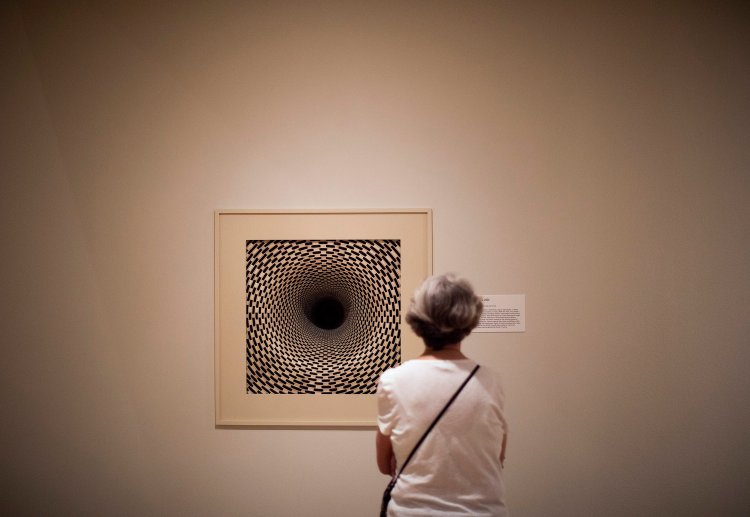

Meredith Sweet, of Long Island, reads about Frey’s three-dimensional sculpture “Caesura.” The word caesura is defined as a pause, interruption, or break, often in a line of poetry or music. Derek Davis/Staff Photographer
He wanted to make a video. He wanted to try prints. He wanted to be represented by a commercial gallery. De Simone brought those goals to the Portland Museum of Art and began planning his first solo show. She left the museum in 2022 for her current position at the Farnsworth but remained connected to the project. Mize helped bring the exhibition to the finish line. “Woven” includes a short and striking video, as well as a series of relief prints made with woven ash. One piece – “Caesura” (2023) – is a sculpture built into the gallery wall, a sort of inverted basket with a kaleidoscopic effect.
“He needs a new set of goals right now because he’s already accomplished all the ones he articulated in 2021,” De Simone said. “I hope he can figure out what that means for him, whether he’s going to maintain that pace. Sometimes artists need to build in a moment of self reflection.”
On a hot summer day, Frey sat in his cool studio and split ash into thin strips. A shelf on the back wall was full of basket forms Frey made himself; an upside-down work-in-progress waited nearby. While many prominent artists have studio assistants, Frey is too much of a perfectionist to cede most tasks to someone else. He does have an apprentice now – Caleb Hoffman, Secord’s son. He cannot keep up with the demand for his work, even as the gallery now manages his business. He misses personal connections at markets but doesn’t miss negotiating prices there. It’s all a little surreal, he said, like something out of a movie.
“There’s certain parts of it where you have imposter syndrome,” he said. “And there’s other parts where you look around and think, ‘This is happening right now. People aren’t faking this. These aren’t fake reviews. You’re in Manhattan with an ancient craft that your family has done for seven generations.’ That was amazing.”
Related Stories





